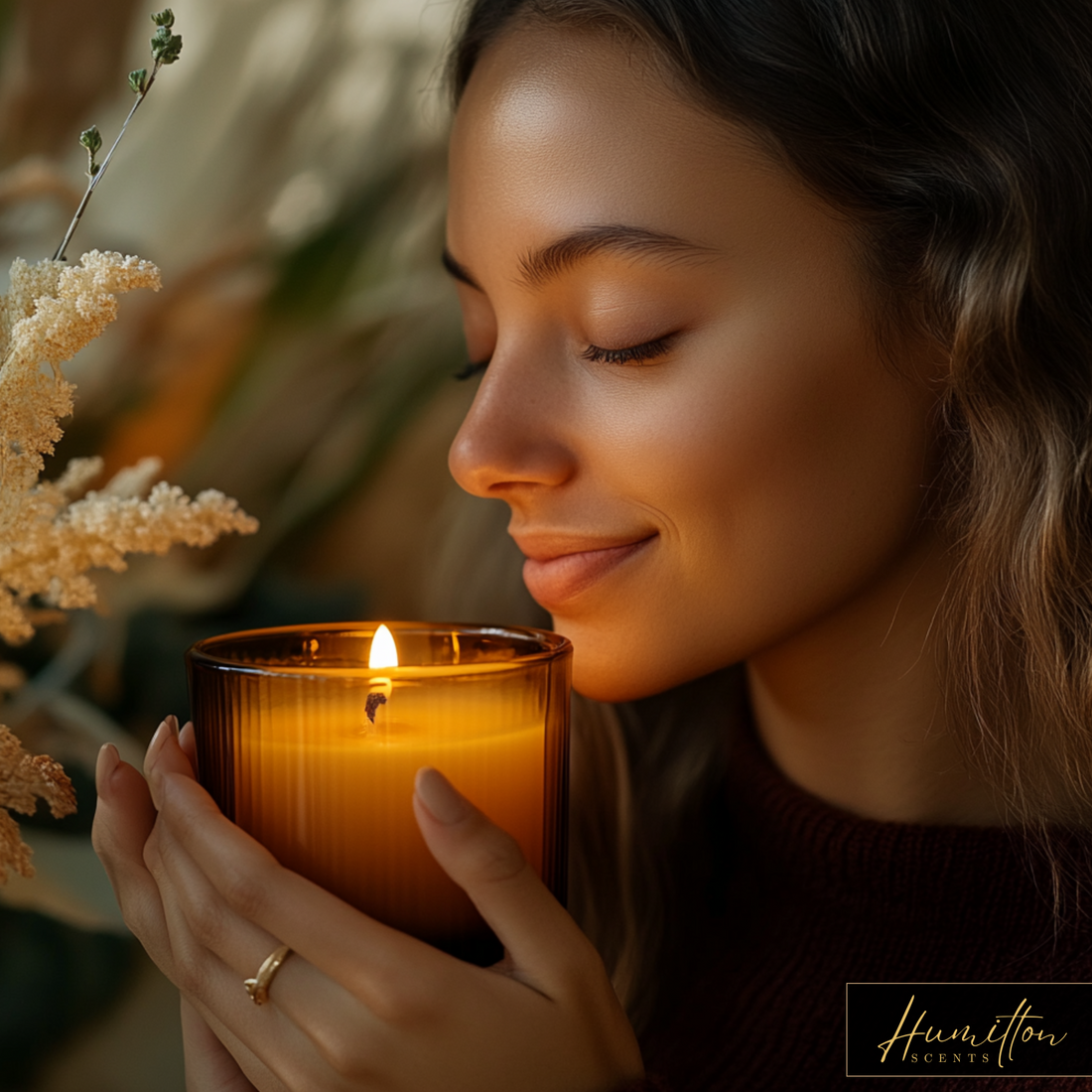Candles do more than provide light and ambiance—they can transform a room with their fragrance. But have you ever lit a candle only to find its scent barely noticeable? Or wondered why some candles seem to fill an entire house with their aroma? The answer lies in scent throw, a term that describes how well a candle disperses its fragrance. In this blog, we’ll dive into what scent throw is, how it works, and how you can maximize it for the best candle experience.

What Is Scent Throw?
Scent throw refers to the ability of a candle to release and spread its fragrance into the surrounding environment. It’s divided into two types:
- Cold Throw: The fragrance you smell when the candle is unlit, like when it’s sitting on a shelf or when you first open its container. This is the candle’s “first impression” and often influences a buyer’s decision.
- Hot Throw: The fragrance released when the candle is burning. This is what fills your space with scent and is typically the primary goal for candle enthusiasts.
Both cold and hot throw matter, but hot throw is what most people associate with a candle’s performance. A strong hot throw means the scent travels farther and lingers longer, creating an immersive experience.
How Does Scent Throw Work?
Scent throw is the result of a complex interplay between the candle’s components and the environment. Here’s a breakdown of how it works:
1. The Role of Wax
The type of wax used in a candle significantly affects scent throw. Common waxes include:
- Paraffin: Known for excellent scent throw due to its ability to hold and release fragrance oils effectively. However, it’s petroleum-based, which some consumers avoid.
- Soy: A natural, eco-friendly option that offers a clean burn. Soy wax holds fragrance well but may release it more slowly than paraffin, sometimes resulting in a subtler hot throw.
- Beeswax: Naturally fragrant with a honey-like scent, beeswax doesn’t hold added fragrances as well as other waxes, which can limit its scent throw.
- Coconut or Blends: These are gaining popularity for their balance of sustainability and strong scent throw, often performing well for both cold and hot throw.
The wax acts as a carrier for the fragrance oil, releasing it into the air as the candle burns. The wax’s melting point and composition influence how quickly and evenly the fragrance is dispersed.
2. Fragrance Oil and Load
Fragrance oils are the heart of a candle’s scent. The fragrance load—the percentage of fragrance oil in the wax—typically ranges from 6% to 12%. A higher load generally means a stronger scent throw, but there’s a limit. Too much oil can clog the wick, cause poor burning, or even mute the fragrance due to incomplete combustion.
The quality of the fragrance oil also matters. High-quality oils are formulated for candles, with a balance of top, middle, and base notes to ensure the scent evolves beautifully as it burns. Cheap oils may smell strong initially but fade quickly or burn off unevenly.
3. The Wick’s Importance
The wick is the engine of the candle, controlling how the wax burns and how the fragrance is released. A properly sized wick ensures a consistent melt pool (the liquid wax around the flame), which is critical for hot throw. If the wick is too small, the melt pool will be shallow, limiting fragrance release. If it’s too large, the candle may burn too hot, consuming the fragrance oil too quickly.
Wick materials also play a role:
- Cotton wicks: Clean-burning and common, but they may require trimming to maintain an optimal flame.
- Wood wicks: Create a wider melt pool and a crackling sound, often enhancing hot throw by increasing the burn surface area.
4. Candle Design and Container
The candle’s shape, size, and container influence how scent disperses. For example:
- A wide, shallow container allows for a larger melt pool, promoting a stronger hot throw.
- A tall, narrow jar may restrict airflow, reducing scent dispersion.
- Multi-wick candles often have a better hot throw because they create a larger, more consistent melt pool.
5. Environmental Factors
Even the best candle can’t perform if the environment isn’t right. Factors like room size, airflow, and humidity affect scent throw:
- Room Size: A small candle in a large room may struggle to fill the space, while a large candle in a small room can be overwhelming.
- Airflow: Drafts or open windows can disperse the scent too quickly, weakening the hot throw.
- Humidity: High humidity can dampen fragrance molecules, making the scent less noticeable.
Tips for Maximizing Scent Throw
Whether you’re a candle maker or a candle lover, here are some practical tips to ensure your candles deliver the best scent throw possible:
-
Choose the Right Wax and Fragrance Combo
Experiment with wax types and fragrance oils to find the best match. For example, soy wax pairs well with high-quality, candle-specific fragrance oils for a balanced throw. Test different fragrance loads to hit the sweet spot without overloading the wax. -
Select the Correct Wick
Match the wick size to the candle’s diameter. Most wick manufacturers provide sizing charts to guide you. For stronger hot throw, consider a slightly larger wick or a wood wick, but avoid oversized wicks that cause sooting or uneven burning. -
Let the Candle Cure
After pouring a candle, let it cure for 1–2 weeks (depending on the wax type). This allows the fragrance oil to fully bind with the wax, enhancing both cold and hot throw. Soy candles, in particular, benefit from a longer curing time. -
Burn Properly
For the best hot throw, let the candle burn long enough to form a full melt pool (usually 1 hour per inch of diameter). This ensures even fragrance release and prevents tunneling, where wax builds up around the wick. -
Consider the Environment
Place candles in appropriately sized rooms and avoid drafty areas. For larger spaces, use multi-wick candles or multiple candles to amplify the scent. Burning candles in low-humidity environments can also help the fragrance carry better. -
Store Candles Properly
To preserve cold throw, store unlit candles in a cool, dark place, ideally in airtight containers or bags. This prevents fragrance oils from evaporating over time.
Troubleshooting Common Scent Throw Issues
- Weak Hot Throw: Check the wick size, fragrance load, or wax type. Ensure the candle is burning long enough to form a full melt pool. If the issue persists, the fragrance oil may not be suitable for the wax or may be of low quality.
- Weak Cold Throw: This often points to a low fragrance load or insufficient curing time. High-quality oils and proper storage can also help.
- Scent Fades Quickly: This could be due to an oversized wick burning too hot or a fragrance oil with weak base notes. Adjust the wick or choose a more robust oil.
Conclusion
Scent throw is the magic that makes candles more than just a light source—it’s what turns a room into a cozy haven or a vibrant sensory experience. By understanding the science behind scent throw and making thoughtful choices about wax, wicks, fragrance oils, and burning conditions, you can create or enjoy candles that deliver unforgettable aromas. Whether you’re crafting your own candles or selecting the perfect one for your home, mastering scent throw will elevate your candle game to the next level.
So, next time you light a candle, pay attention to its scent throw. Is it filling the room as you’d hoped? If not, you now have the tools to make it shine—or rather, smell—brighter!
Happy candle burning!

Why Humilton Scents?
This deep dive into scent throw is inspired by the passion and craftsmanship of Humilton Scents, a brand dedicated to creating candles that captivate the senses. At Hamilton Scents, every candle is meticulously designed to balance wax, wick, and fragrance for an exceptional cold and hot throw, ensuring your space is filled with luxurious, long-lasting aromas. It’s their commitment to quality and sensory excellence that motivates us to explore and share the art and science of scent throw.

